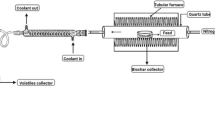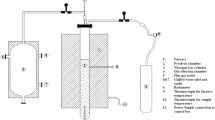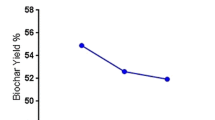Abstract
The properties of biochar produced by pyrolysis are strongly influenced by various factors such as feedstock. Cabbage makes up around 6.5% of global vegetable production with around 30% wasted from the farm to plate, making it a considerable and widely available biochar feedstock. This study investigates the optimization of three design factors, namely, pyrolysis temperature, feed particle size, and quantity of waste cabbage biomass to produce biochar. Feed particle size was selected due to its relevance to solar or other drying pretreatment, necessary for moisture reduction. To evaluate the influence of these parameters and find their optimum conditions, response surface methodology (RSM) with a central composite design of experiments was used. Optimum response for cabbage biochar was observed at lower temperature (360 °C) with particle size of 0.90 mm and a relatively low quantity, though this latter parameter had minimal influence on most response parameters. Temperature was the most influential parameter on all response variables, although particle size was important for nitrogen content, cation exchange capacity (CEC), and electrical conductivity. Biochar produced at an optimum pyrolysis temperature of 360 °C and nearest practical size of 1 mm was tested with Ipomoea purpurea in sandy soil. Two percent biochar loading provided an increase in water retention from 6.5% in the control to 10% in the biochar amended soil (p = 0.016). Increases were also observed in plant height and leaf production but were not statistically significant at α = 0.05.







Similar content being viewed by others
References
Zhao S, Ta N, Wang X (2017) Effect of temperature on the structural and physicochemical properties of biochar with apple tree branches as feedstock material. Energies 10:1293. https://doi.org/10.3390/en10091293
Ahmadvand M, Soltani J, Hashemi Garmdareh SE, Varavipour M (2018) The relationship between the characteristics of biochar produced at different temperatures and its impact on the uptake of NO3--N. Environ Health Eng Manag 5:67–75. https://doi.org/10.15171/EHEM.2018.10
Beniche I, Hungría J, El Bari H et al (2020) Effects of C/N ratio on anaerobic co-digestion of cabbage, cauliflower, and restaurant food waste. Biomass Conv Bioref. https://doi.org/10.1007/s13399-020-00733-x
Sagar NA, Pareek S, Sharma S, Yahia EM, Lobo MG (2018) Fruit and vegetable waste: bioactive compounds, their extraction, and possible utilization. Compr Rev Food Sci Food Saf 17:512–531. https://doi.org/10.1111/1541-4337.12330
FAO (Food and Agriculture Organization) (2014) Definitional framework of food losses and waste. Rome, Italy
Laufenberg G, Schulze N (2009) A modular strategy for processing of fruit and vegetable wastes into value-added products. In: Waldron K (ed) Handbook of Waste Management and Co-Product Recovery in Food Processing. Woodhead Publishing, pp 286–353
FAOSTAT (2019) Statistics for climate change in agriculture, forestry and other land
Hossain MA, Ngo HH, Guo WS, Nguyen TV, Vigneswaran S (2014) Performance of cabbage and cauliflower wastes for heavy metals removal. Desalin Water Treat 52:844–860. https://doi.org/10.1080/19443994.2013.826322
Sun X, Shan R, Li X, Pan J, Liu X, Deng R, Song J (2017) Characterization of 60 types of Chinese biomass waste and resultant biochars in terms of their candidacy for soil application. GCB Bioenergy 9:1423–1435. https://doi.org/10.1111/gcbb.12435
Khukutapan D, Chiewchan N, Devahastin S (2018) Characterization of nanofibrillated cellulose produced by different methods from cabbage outer leaves. J Food Sci 83:1660–1667. https://doi.org/10.1111/1750-3841.14160
Rutherford DW, Wershaw RL, Rostad CE, Kelly CN (2012) Effect of formation conditions on biochars: compositional and structural properties of cellulose, lignin, and pine biochars. Biomass Bioenergy 46:693–701. https://doi.org/10.1016/j.biombioe.2012.06.026
Pradhan S, Abdelaal AH, Mroue K, et al (2020) Biochar from vegetable wastes: agro-environmental characterization. Biochar (in press). https://doi.org/10.1007/s42773-020-00069-9
Brito TBN, Pereira APA, Pastore GM, Moreira RFA, Ferreira MSL, Fai AEC (2020) Chemical composition and physicochemical characterization for cabbage and pineapple by-products flour valorization. LWT 124:109028
Collard F-X, Blin J (2014) A review on pyrolysis of biomass constituents: mechanisms and composition of the products obtained from the conversion of cellulose, hemicelluloses and lignin. Renew Sust Energ Rev 38:594–608
Herranz J, Vidal-Valverde C, Rojas-Hidalgo E (1981) Cellulose, hemicellulose and lignin content of raw and cooked Spanish vegetables. J Food Sci 46:1927–1933. https://doi.org/10.1111/j.1365-2621.1981.tb04521.x
Demirbas A (2004) Effects of temperature and particle size on bio-char yield from pyrolysis of agricultural residues. J Anal Appl Pyrolysis 72:243–248. https://doi.org/10.1016/j.biortech.2012.10.150
Yadav K, Jagadevan S (2019) Influence of process parameters on synthesis of biochar by pyrolysis of biomass: an alternative source of energy. Recent Adv Pyrolysis. https://doi.org/10.5772/intechopen.88204
Zhao B, O’Connor D, Zhang J et al (2018) Effect of pyrolysis temperature, heating rate, and residence time on rapeseed stem derived biochar. J Clean Prod 174:977–987. https://doi.org/10.1016/j.jclepro.2017.11.013
Abbas Q, Liu G, Yousaf B, Ali MU, Ullah H, Munir MAM, Liu R (2018) Contrasting effects of operating conditions and biomass particle size on bulk characteristics and surface chemistry of rice husk derived-biochars. J Anal Appl Pyrolysis 134:281–292. https://doi.org/10.1016/j.jaap.2018.06.018
Cheng J, Liu Y, Li Y et al (2018) Preparation of high contents of pyridinic and pyrrolic-nitrogen doped activated-carbon from pyrolysis of purple cabbage for the catalysis of oxygen reduction reaction. Int J Electrochem 13:11203–11214. https://doi.org/10.20964/2018.11.81
Jo JH, Kim SS, Shim JW, Lee YE, Yoo YS (2017) Pyrolysis characteristics and kinetics of food wastes. Energies 10:1191. https://doi.org/10.3390/en10081191
Campos LMA, Moura HOMA, Cruz AJG, Assumpção SMN, de Carvalho LS, Pontes LAM (2020) Response surface methodology (RSM) for assessing the effects of pretreatment, feedstock, and enzyme complex association on cellulose hydrolysis. Biomass Conv Bioref. https://doi.org/10.1007/s13399-020-00756-4
Jitjamnong J, Thunyaratchatanon C, Luengnaruemitchai A, Kongrit N, Kasetsomboon N, Sopajarn A, Chuaykarn N, Khantikulanon N (2020) Response surface optimization of biodiesel synthesis over a novel biochar-based heterogeneous catalyst from cultivated (Musa sapientum) banana peels. Biomass Conv Bioref. https://doi.org/10.1007/s13399-020-00655-8
Pituya P, Sriburi T, Wijitkosum S (2017) Optimization of biochar preparation from acacia wood for soil amendment. Eng J 21:99–105. https://doi.org/10.4186/ej.2017.21.2.99
Menya E, Olupot PW, Storz H, Lubwama M, Kiros Y, John MJ (2020) Optimization of pyrolysis conditions for char production from rice husks and its characterization as a precursor for production of activated carbon. Biomass Conv Bioref 10:57–72. https://doi.org/10.1007/s13399-019-00399-0
Januszkiewicz J, Sabik H, Azarnia S, Lee B (2008) Optimization of headspace solid-phase microextraction for the analysis of specific flavors in enzyme modified and natural Cheddar cheese using factorial design and response surface methodology. J Chromatogr A 1195:16–24. https://doi.org/10.1016/j.chroma.2008.04.067
Siddiqui MTH, Nizamuddin S, Mubarak NM, Shirin K, Aijaz M, Hussain M, Baloch HA (2019) Characterization and process optimization of biochar produced using novel biomass, waste pomegranate peel: a response surface methodology approach. Waste Biomass Valor 10:521–532. https://doi.org/10.1007/s12649-017-0091-y
Mazac R (2016) Assessing the use of food waste biochar as a biodynamic plant fertilizer. Departmental Honors Projects. 43. College of Liberal Arts, Hamline University. https://digitalcommons.hamline.edu/dhp/43. Accessed Oct 2020
Basak T, Lou Z, Rahman MRT, Azam MS (2014) Quality evaluation of dehydrated (sun and solar drying) cabbage and rehydration properties. Eur Acad Res 2:8214–8243
ASTM (2007) Standard test method for particle-size analysis of soils D 422-63
Dai Z, Meng J, Muhammad N, Liu X, Wang H, He Y, Brookes PC, Xu J (2013) The potential feasibility for soil improvement, based on the properties of biochars pyrolyzed from different feedstocks. J Soils Sediments 13:989–1000. https://doi.org/10.1007/s11368-013-0698-y
Singh B, Dolk MM, Shen Q, Camps-Arbestain M (2017) Biochar pH, electrical conductivity and liming potential. In: Biochar: A Guide to Analytical Methods. Csiro Publishing, Clayton, pp 23–38
ASTM (2010) Standard test method for measuring the exchange complex and cation exchange capacity of inorganic fine-grained soils D7503-10
Qi F, Yan Y, Lamb D, Naidu R, Bolan NS, Liu Y, Ok YS, Donne SW, Semple KT (2017) Thermal stability of biochar and its effects on cadmium sorption capacity. Bioresour Technol 246:48–56. https://doi.org/10.1016/j.biortech.2017.07.033
ASTM (2013) Standard test methods for proximate analysis of coal and coke by macro thermogravimetric analysis D 7582-15
Islam M, Halder M, Siddique MAB, Razir SAA, Sikder S, Joardar JC (2019) Banana peel biochar as alternative source of potassium for plant productivity and sustainable agriculture. Int J Recycl Org Waste Agric 8:407–413. https://doi.org/10.1007/s40093-019-00313-8
Burcu Uzun B, Apaydın-Varol E, Ates F et al (2010) Synthetic fuel production from tea waste: characterisation of bio-oil and bio-char. Fuel 89:176–184. https://doi.org/10.1016/j.fuel.2009.08.040
Jindo K, Mizumoto H, Sawada Y, Sanchez-Monedero MA, Sonoki T (2014) Physical and chemical characterization of biochars derived from different agricultural residues. Biogeosciences 11:6613–6621. https://doi.org/10.5194/bg-11-6613-2014
Junna S, He F, Shao H et al (2016) Effects of biochar application on Suaeda salsa growth and saline soil properties. Environ Earth Sci 75:630. https://doi.org/10.1007/s12665-016-5440-9
Xue S, Zhang X, Ngo HH, Guo W, Wen H, Li C, Zhang Y, Ma C (2019) Food waste based biochars for ammonia nitrogen removal from aqueous solutions. Bioresour Technol 292:121927. https://doi.org/10.1016/j.biortech.2019.121927
Matsumoto S, Ogata S, Shimada H, Sasaoka T, Hamanaka A, Kusuma G (2018) Effects of pH-induced changes in soil physical characteristics on the development of soil water erosion. Geosciences 8:134
Tomczyk A, Sokołowska Z, Boguta P (2020) Biochar physicochemical properties: pyrolysis temperature and feedstock kind effects. Rev Environ Sci Biotechnol 19:191–215. https://doi.org/10.1007/s11157-020-09523-3
Machado R, Serralheiro R (2017) Soil salinity: effect on vegetable crop growth. Management practices to prevent and mitigate soil salinization. Horticulturae 3:–13. https://doi.org/10.3390/horticulturae3020030
Domingues RR, Trugilho PF, Silva CA, Melo ICNA, Melo LCA, Magriotis ZM, Sánchez-Monedero MA (2017) Properties of biochar derived from wood and high-nutrient biomasses with the aim of agronomic and environmental benefits. PLoS One 12:e0176884. https://doi.org/10.1371/journal.pone.0176884
Piash MI, Hossain MF, Parveen Z (2016) Physico-chemical properties and nutrient content of some slow pyrolysis biochars produced from different feedstocks. Bangladesh J Sci Res 29:111–122. https://doi.org/10.3329/bjsr.v29i2.32327
Clough TJ, Condron LM, Kammann C, Müller C (2010) Biochar and the nitrogen cycle: introduction. J Environ Qual 39:1218–1223. https://doi.org/10.2134/jeq2010.0204
Gao G, Falconer RA, Lin B (2015) Modelling the fate and transport of faecal bacteria in estuarine and coastal waters. Mar Pollut Bull 100:162–168. https://doi.org/10.1016/j.marpolbul.2015.09.011
Rawat J, Saxena J, Sanwal P (2019) Biochar: a sustainable approach for improving plant growth and soil properties. In biochar-an imperative amendment for soil and the environment. Fruit and vegetable waste: bioactive compounds, their extraction, and possible utilization. DOI: https://doi.org/10.5772/intechopen.82151
Budai A, Zimmerman AR, Cowie AL, et al (2013) Biochar carbon stability test method: an assessment of methods to determine biochar carbon stability. Int Biochar Initiat 1–10
Billa SF, Angwafo TE, Ngome AF (2019) Agro-environmental characterization of biochar issued from crop wastes in the humid forest zone of Cameroon. Int J Recycl Org Waste Agric 8:1–13. https://doi.org/10.1007/s40093-018-0223-9
Stella Mary G, Sugumaran P, Niveditha S, Ramalakshmi B, Ravichandran P, Seshadri S (2016) Production, characterization and evaluation of biochar from pod (Pisum sativum), leaf (Brassica oleracea) and peel (Citrus sinensis) wastes. Int J Recycl Org Waste Agric 5:43–53. https://doi.org/10.1007/s40093-016-0116-8
Funding
The authors would like to thank Qatar National Research Fund for their support of this research through NPRP-11S-0117-180328, and co-funding from Qatar Supreme Committee for Delivery and Legacy through the Challenge 22 program.
Author information
Authors and Affiliations
Corresponding author
Ethics declarations
Conflict of interest
The authors have no conflicts of interest to declare. Any opinions, findings, conclusions, or recommendations expressed in this material are those of the author(s) and do not necessarily reflect the views of HBKU, QF, or Supreme Committee for Delivery and Legacy.
Additional information
Publisher’s note
Springer Nature remains neutral with regard to jurisdictional claims in published maps and institutional affiliations.
Electronic supplementary material
ESM 1
(PDF 962 kb)
Rights and permissions
About this article
Cite this article
Pradhan, S., Shahbaz, M., Abdelaal, A. et al. Optimization of process and properties of biochar from cabbage waste by response surface methodology. Biomass Conv. Bioref. 12, 5479–5491 (2022). https://doi.org/10.1007/s13399-020-01101-5
Received:
Revised:
Accepted:
Published:
Issue Date:
DOI: https://doi.org/10.1007/s13399-020-01101-5




